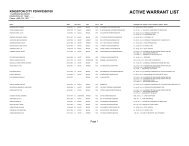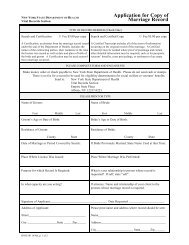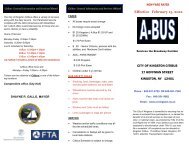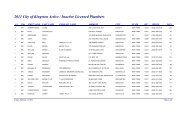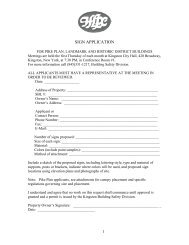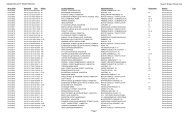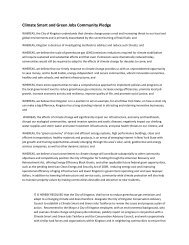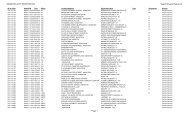A Walking Tour of The Chestnut Street Historic ... - City of Kingston
A Walking Tour of The Chestnut Street Historic ... - City of Kingston
A Walking Tour of The Chestnut Street Historic ... - City of Kingston
Create successful ePaper yourself
Turn your PDF publications into a flip-book with our unique Google optimized e-Paper software.
A <strong>Walking</strong> <strong>Tour</strong> <strong>of</strong><strong>The</strong> <strong>Chestnut</strong> <strong>Street</strong> <strong>Historic</strong>DistrictAnd Neighborhood****Sponsored by theFriends <strong>of</strong> <strong>Historic</strong> <strong>Kingston</strong>“Up on the Hill.” As the village <strong>of</strong>Rondout prospered and grew, some <strong>of</strong>its leading citizens began to build homesalong the ridge overlooking the village..Near the highest point, in about 1850,James McEntee built the first home, inthe style now sometime called “HudsonRiver Bracketed.” McEntee had arrivedin Rondout in 1825 as a young man freshfrom working on the Erie Canal, with anew job as resident engineer for theDelaware and Hudson Canal Company.In 1848, after a series <strong>of</strong> workenterprises, he bought 52 undevelopedacres overlooking the village and laid outa street with building lots. <strong>The</strong> streetand lots first appeared on a map in 1851.On an 1858 map, it was first called<strong>Chestnut</strong> <strong>Street</strong>.Looking down <strong>Chestnut</strong> <strong>Street</strong> hillAmong McEntee’s first neighbors wereDr. Abraham Crispell, a physician whohad fought the cholera epidemic <strong>of</strong> 1849from his <strong>of</strong>fice in the Mansion HouseHotel downtown; James Van Deusen,who with his brother, Columbus, madepatent medicines advertised to curealmost everything; and Henry Samson,who came to Rondout after making asmall fortune in leather tanning.By the turn <strong>of</strong> the century, McEntee’shouse was overshadowed by the largemansion built on part <strong>of</strong> the McEnteehomestead by Samuel D. Coykendall,President <strong>of</strong> the Cornell SteamboatCompany. Like some other ll-to-doresidents, Coykendall enjoyed beingclose to work; in the morning, he and hissons walked down the hill to the CornellBuilding (in the evening, they weredriven back up the hill by carriage).James McEnteeBy 1920, postcard views show a “mature”street shaded with graceful maples andelms. Families in the larger homesmaintained gardens, though none moretastefully than that <strong>of</strong> EdwardCoykendall’s wife, Isabel. From acarefully arbored doorway, visitors couldview the church-spired village below andthe creek and river beyond.Invariably, the houses on the streetchanged with the changes in Rondout’sfortunes and those <strong>of</strong> its leading familiesand also as the result <strong>of</strong> new buildingstyle preferences. By 1970, theCoykendall mansion, long vacant, hadbeen torn down to make room for asmall development <strong>of</strong> ranch style houses;several <strong>of</strong> the larger houses had becomemultiple-unit dwellings; and some <strong>of</strong> theshade trees had been lost. Yet, much <strong>of</strong>the streetscape remains as it was at theturn <strong>of</strong> the century. Most <strong>of</strong> the homes,many now restored, remain to remind us1
<strong>of</strong> the domestic life <strong>of</strong> the people whoran the industries and owned thebusinesses down the hill.<strong>The</strong> last long block at the western end <strong>of</strong>West <strong>Chestnut</strong> arose as a separatedevelopment, beginning about 1870.Many <strong>of</strong> the residents in this block <strong>of</strong>middle-class homes worked in thetransportation and other enterprisesowned by the residents at the wealthierend <strong>of</strong> the street.<strong>The</strong> Self-Guided <strong>Tour</strong> starts in <strong>Kingston</strong>at the fork <strong>of</strong> Broadway and DelawareAvenue and continues to East <strong>Chestnut</strong>,Livingston, and Stuyvesant <strong>Street</strong>s, andthen to the end <strong>of</strong> West <strong>Chestnut</strong>. Ittakes about an hour (though probablylonger if accompanied by a guide). Anoptional visit to Montrepose Cemetery isdescribed.Broadway at Delaware. It takes someimagination to envision these busythoroughfares as the rude paths theyonce were, likely in use by nativeAmericans long before Europeans arrivedin the 1600s. River travelers coulddebark at what is now <strong>Kingston</strong> Pointand come up the path known today asDelaware Avenue toward the fertilesettlements along the Esopus floodplain(near uptown <strong>Kingston</strong>). Or they couldmake a more sheltered landing upRondout Creek and come up the path weknow as Broadway. On October 15,1777, British General Henry Clinton’stroops came up the road from the “point”on their way to set fire to <strong>Kingston</strong>. By1819, this road had become the first part<strong>of</strong> a proposed Ulster and DelawareTurnpike intended to go as far as theDelaware River in Chenango County.<strong>The</strong> turnpike venture failed, but the“Delaware” part <strong>of</strong> the name stayed onlocal street maps.In 1820, a house with a tavern sign stoodabout where the present-dayconvenience store is located. Except fora frame house further down Broadway(where St. Mary’s church would be built),there were no other dwellings until yougot close to the Creek.An early local map shows Broadway as“the Strand road” (meaning the road toor from the strand, a Dutch word for“beach” or “landing”). In 1850-51, woodplanks were laid down for what wasthen called the Union Plank Road. By1875, now known as Union Avenue, theplanks were up and a horse-drawntrolley carried people between Rondoutand uptown <strong>Kingston</strong>.262 Broadway. About 1870, near thepeak <strong>of</strong> Rondout’s prosperity, the Cashier<strong>of</strong> the First National Bank <strong>of</strong> Rondout,Charles Bray, moved into this substantialhouse. In 1875, the house was depictedin Beer’s Atlas <strong>of</strong> Ulster County withfashionably dressed men and womenstrolling along this part <strong>of</strong> Union Avenue.Rondout and <strong>Kingston</strong> had combinedunder a single city charter and, by 1885,Bray was serving as Mayor.<strong>The</strong> home <strong>of</strong> Charles Bray in 1875<strong>The</strong> plans for Bray’s house may havebeen taken or adapted by a localcarpenter from published designs bystyle-makers such as Alexander JacksonDavis, Andrew Jackson Downing, orCalvert Vaux. <strong>The</strong>se building designersfound ideas in picturesque Europeanmodels and adapted them for American2
materials and convenience. <strong>The</strong> mostprevalent model for larger homes in the1850-1880 period was the Italian villa orcountry house, and the Bray house, likeothers built in <strong>Kingston</strong> in this period,shows the influence <strong>of</strong> what architecturalhistorians would someday call the“Italianate.” In the Bray house, theItalianate is evident in the smalloctagonal window under the front gable,the bay window on the side, and theunusual balcony on the front dormer.<strong>The</strong> decorations around the windowsmay have been the builder’s owninspiration. Far from looking like a villain Italy, this house shows howoptimistically American a few Europeanideas could be made to look.<strong>The</strong> same local limestone used to buildthe early Dutch houses in uptown<strong>Kingston</strong> is used here to support anornamental cast-iron fence.261 Broadway. Across the street, themansard ro<strong>of</strong> is associated with anotherpopular style <strong>of</strong> the period, the FrenchSecond Empire. Other elements <strong>of</strong> thehouse seem Italianate. <strong>The</strong> irontethering post in front may be a lateraddition, but it reminds us that thesounds and smells <strong>of</strong> horses, carriages,and wagons were once an important part<strong>of</strong> life in this neighborhood.251 Broadway. Also built about 1870,this Italianate town house has anornamental cornice and bracketscovering the front <strong>of</strong> the building.249 Broadway. Probably built in the1880s, this front-gabled frame houserepresents the less expensive house <strong>of</strong>the period and is a modest example <strong>of</strong>what has been called “Folk Victorian.”<strong>The</strong> plan was probably from a standardpattern book for houses. <strong>The</strong> gable trimand decorative porch spandrels possiblycame pre-cut from a local mill. <strong>The</strong>garage is a later addition.NW Corner <strong>of</strong> Broadway and<strong>Chestnut</strong>. Recently rehabilitated, thisbrick house appears on an 1851 map andhas had several additions. Decorativeverge board under the ro<strong>of</strong> line and afront porch have unfortunately beenremoved.254 and 250 Broadway. Built about1900, these two houses represent twoapproaches to the style known asColonial Revival. During thePhiladelphia Centennial Exposition <strong>of</strong>1876, Americans were reminded <strong>of</strong> thebest <strong>of</strong> their earlier, classical styles inarchitecture (Georgian, Federal, andGreek Revival), encouraging a newinterest in classical ideas and motifs thatbecame the predominant new style forhouses by 1900. 254 Broadway, with asemicircular window in the front gableand front porch with single columns,exemplifies the typical in frame houseconstruction in this style. <strong>The</strong> Terpeningfamily, local ice cream makers, oncelived here. 250 Broadway seems arevival <strong>of</strong> the Federal style <strong>of</strong> 1810-30with its matched dormers, spaced dentilmolding in the cornice, and balancedconfiguration. <strong>The</strong> Italianate is seen inthe side bay window. (<strong>The</strong> front porchhas been modified.)NE Corner <strong>of</strong> Broadway and<strong>Chestnut</strong>. Not all the houses built inthis neighborhood have survived and afew houses replace earlier ones. Untilabout 1900, a sizable house stood on thisnow vacant lot. Behind it, on East<strong>Chestnut</strong>, stood another house, no longerexisting, owned by Captain David Abbey,who piloted steamboats on the river forThomas Cornell.Bluestone Sidewalks. Like other olderneighborhoods <strong>of</strong> <strong>Kingston</strong>, <strong>Chestnut</strong><strong>Street</strong> retains its distinctive bluestonesidewalks and curbstones. <strong>The</strong>bluestone likely arrived in a horse and3
wagon after being prepared in yardsalong the Rondout. <strong>The</strong> quarries werelocated in Hurley and other nearbycommunities.11 East <strong>Chestnut</strong>. Built about 1906, thisis an early example <strong>of</strong> the Tudor stylethat was widely popular by the 1920s.This style shared common roots with theCraftsman style, which emphasizedsimplicity and the value <strong>of</strong> hand-work(evident in the carpentry details in thishouse’s interior). Tudor <strong>of</strong>ten included,as this house does, stucco walls withdecorative half-timbering, steeply pitchedro<strong>of</strong>s, and a gabled doorway. <strong>The</strong> firstresidents were Dr. George Chandler andhis family. Chandler, a founder <strong>of</strong><strong>Kingston</strong> Hospital, was rather moreremarkably also the founder <strong>of</strong> the NewYork State Police.17 East <strong>Chestnut</strong>. Also built about 1906in a Colonial Revival style, an earlyresident was Grove Webster, who owneda livery stable in Rondout. Websterserved terms as county Sheriff and as<strong>Kingston</strong>’s Mayor. <strong>The</strong> carriage house inthe rear may have been built earlier byCaptain Abbey.Edgar Newkirk house in 1875 with cupola10 East <strong>Chestnut</strong>. This substantialresidence, <strong>of</strong> which the rear is seen fromEast <strong>Chestnut</strong>, was probably built byEdgar B. Newkirk in about 1860.Newkirk was Cashier <strong>of</strong> the RondoutNational Bak and a land developer inRondout. In Beers’ 1875 atlas, the Italianvilla style house is shown with aprominent cupola along with gazebo,birdhouse and weeping willows. A laterowner was Dr. David Kennedy, a patentmedicine manufacturer (“Dr. Kennedy’sFavorite Remedy”) who was also Mayor<strong>of</strong> <strong>Kingston</strong> in 1892-95. A later resident,Jay Klock, published the <strong>Kingston</strong> DailyFreeman.Emmanuel Lutheran Church was builtin 1870 for a German-speakingcongregation. <strong>The</strong> spire was added in1880. For many years, the churchconducted a school in its adjacentbuilding. <strong>The</strong> bell in the tower is one <strong>of</strong>several that have run for the pasthundred years from churches in theneighborhood.Vacant Lot across from the Church.Here was the home <strong>of</strong> John Dillon,partner in McEntee and Dillon. <strong>The</strong>iriron works in Rondout, located on theStrand, made some <strong>of</strong> the cast-ironstorefronts for commercial buildings onlower Broadway and the Strand. Dillon’swife, Julia, acquired a reputation as askilled painter <strong>of</strong> still life and was acousin and close friend <strong>of</strong> another<strong>Chestnut</strong> <strong>Street</strong> painter, Jervis McEntee.18 Livington. Until recently, thisunusual clapboard and shingle housewith three front-facing gables had neverbeen painted. Built about 1885 forGuilford Hasbrouck, who owned a bootand shoe business in Rondout, the househas a number <strong>of</strong> elements <strong>of</strong> the QueenAnne style. Hasbrouck was a grandson<strong>of</strong> Abraham Hasbrouck, the farmer andsloop owner on whose land much <strong>of</strong>commercial Rondout was built.29-31 and 33-35 Stuyvesant. Builtabout 1890, these houses show theQueen Anne style influence in their use<strong>of</strong> decorative shingles and ornamentalcarving under the gables.4
End <strong>of</strong> Stuyvesant <strong>Street</strong>. Before therecent creation <strong>of</strong> the 9-W bypasshighway, Stuyvesant <strong>Street</strong> continueddown the hill into the neighborhood <strong>of</strong>Ponkhockie.34 Stuyvesant. An early resident wasAbsalom Eltinge Anderson, who hadsucceeded his father, Absalom LentAnderson, as Captain <strong>of</strong> the Hudson’sbest-known steamboat, the “MaryPowell.” Obscured by asphalt shinglesfor a number <strong>of</strong> years, the clapboardexterior has been carefully restored bythe present owners. <strong>The</strong> interior hasalso been restored to the 1885 period.34 Stuyvesant <strong>Street</strong> with historic 1885 colors32 and 28 Stuyvesant. <strong>The</strong>se SecondEmpire style brick town houses wereprobably built in the 1870s. In 1895,Conrad Hasbrouck lived at 28. A brother<strong>of</strong> Guilford, Conrad owned a hardwarebusiness on the Strand.18-24 Stuyvesant. P. J. Flynn, asuccessful merchant <strong>of</strong> “groceries,provisions, and liquors” down the hill,lived here with his large family as earlyas 1885. This splendid example <strong>of</strong> theSecond Empire, built about 1865, has anot uncommon cupola with its ownmansard ro<strong>of</strong>. Noteworthy are thedormers with double windows, thedecorative lintels about paired-archwindow panes, and the coupled supportcolumns on the front porch. Untilrecently, fancy ironwork decorated thecrest <strong>of</strong> the cupola and main ro<strong>of</strong>.Porch and window details at 18-24 Stuyvesant8-12 Stuyvesant. <strong>The</strong> original frontporch (which had been removed) andother features <strong>of</strong> this Queen Anne stylehouse have been partly restored. In1895, Michael F. Larkin, Jr., owner <strong>of</strong> agrocery and liquor store at 30 Ferry<strong>Street</strong>, lived here.Site <strong>of</strong> Chambers <strong>Street</strong>. Until the1880s and possibly later, Chambers <strong>Street</strong>came through to Stuyvesant just beforethe vacant lot on the corner <strong>of</strong>Broadway. (<strong>The</strong> house that was formerlyon the vacant lot burned down during anattempt at restoration.)Looking Up West<strong>Chestnut</strong>.<strong>Chestnut</strong> <strong>Street</strong>first appears on amap in 1851,though unnamedat that time.(What became East <strong>Chestnut</strong> was thencalled “Suydam <strong>Street</strong>.” <strong>The</strong> rest <strong>of</strong> thestreet would later be designated West<strong>Chestnut</strong>.) In 1851, only one housestood on the street, that <strong>of</strong> James S.McEntee, who in 1848 had purchased 52acres, including all <strong>of</strong> the hill or ridgedown to Broadway. In prior years, theland, which originally had been part <strong>of</strong> avillage “commons,” had belonged toCornelius Van Buren and was either5
farmland or unused. McEntee, anengineer, may have laid the street outhimself; about this time (1850-51), hewas also supervising the building <strong>of</strong> theUnion Plank Road (on what is nowBroadway). He also subdivided the landalong <strong>Chestnut</strong> <strong>Street</strong> into the lots onwhich the present houses are built.McEntee’s development ended whereAugusta <strong>Street</strong> intersects West <strong>Chestnut</strong>today; the farther end <strong>of</strong> <strong>Chestnut</strong> wasdeveloped separately.“<strong>The</strong> Weinberg.” <strong>The</strong> ridge along whichWest <strong>Chestnut</strong> runs was sometimesknown in the 19 th century as “theWeinberg” (Dutch for “wine hill”).Perhaps (no one today remembers) thiswas because <strong>of</strong> the wild grapevines thatinfested the trees on the side <strong>of</strong> the ridgetoward the Rondout. In the summer,looking up from McEntee <strong>Street</strong> on thedownhill side <strong>of</strong> <strong>Chestnut</strong>, some vinesare still in evidence.12 West <strong>Chestnut</strong>. Built in 1900 (thecornerstone can be seen from the street),this solidly upper-class home attests tothe prosperous economic status <strong>of</strong> theresidents who lived on this end <strong>of</strong> West<strong>Chestnut</strong> (which we might well think <strong>of</strong>as an affluent, close-in suburb <strong>of</strong>Rondout). Its 14 rooms, six bathrooms,six fireplaces, and maid’s quarters werehome in 1905 to Amos Van Etten, alawyer with an <strong>of</strong>fice on Ferry <strong>Street</strong>, hiswife, at least three children, and a live-inmaid. A later resident, Howard Lewis, anexecutive with American Motors,commuted to and from the city in hisNash.15 West <strong>Chestnut</strong>. In 1875, when thisSecond Empire style house was new, itwas the home <strong>of</strong> Hiram Roosa, who soldinsurance and real estate from his <strong>of</strong>ficein the Mansion House. In 1875, agazebo stood on the downhill side. Abay-window on the front left and anopen porch on the front right <strong>of</strong> thehouse have been replaced by the presentclosed porch. A later resident, GeorgeCoykendall, lived here before moving toa more impressive house at 77 West<strong>Chestnut</strong>.18 West <strong>Chestnut</strong>. This imposing stonehouse in the Colonial Revival style wasbuilt about 1904 by George Hutton, one<strong>of</strong> several brick manufacturers who livedon West <strong>Chestnut</strong>. <strong>The</strong> Hutton brickyardwas started by William Hutton, George’sfather (see 32 West <strong>Chestnut</strong>). ColonialRevival style houses in stone are unusual.<strong>The</strong> dormer with a broken pediment ischaracteristic <strong>of</strong> houses in this style builtabout 1900. Like other homes on thisside <strong>of</strong> the street, an elaborate gardenwas maintained in the rear with hiredgardeners.19 West <strong>Chestnut</strong>. One <strong>of</strong> the firstpeople to buy a house lot from JanesMcEntee must have been John Gill, alocal builder, who lived here andprobably built this distinctly Italianatehome. Notable are the arched windows,low-pitched ro<strong>of</strong>, bay windows, andstone quoins at wall corners and inwindows. From about 1885 until wellinto the 20 th century, this house was thehome and <strong>of</strong>fice <strong>of</strong> Dr. Abraham P.Chalker, a homeopathic physician.6
Gill-Chalker house at 19 West <strong>Chestnut</strong>30 West <strong>Chestnut</strong>. <strong>The</strong> late 1960s splitlevelranch style house was built on thesite <strong>of</strong> the George Washburn house,which burned down in recent times.Washburn was another prosperous brickmanufacturer. His house, built about thesame time as the George Hutton housenext door, was an elaborate specimen <strong>of</strong>the Colonial Revival and was pictured ona local postcard about 1913.WellesLane.Owners <strong>of</strong>houses atthis end <strong>of</strong>West<strong>Chestnut</strong>generallyhad carriage houses (which later became“garages”) in the rear or downhill side <strong>of</strong>the house. <strong>The</strong> Chalker family kept ahorse and wagon in the buildingpresently behind 19 West <strong>Chestnut</strong> onWelles Lane, a street built specifically toreach the carriage houses back <strong>of</strong> thehouses on this side <strong>of</strong> West <strong>Chestnut</strong>(even before Orchard <strong>Street</strong> was laidout). In the 1915-18 period, theWashburns still kept a horse or two intheir garage on Orchard <strong>Street</strong> at a timewhen Mr. Washburn was driven to workdaily in his red Pierce-Arrow. (See alsothe carriage houses on Augusta <strong>Street</strong>.)Henry Samson house at 32 West <strong>Chestnut</strong>32 West <strong>Chestnut</strong>. Probably the builderand first resident <strong>of</strong> this house wasHenry Samson, who purchased the landfrom James McEntee in 1857. <strong>The</strong> houseappears on French’s Ulster County map<strong>of</strong> 1858 as one <strong>of</strong> only four houses onthe street. <strong>The</strong> architect <strong>of</strong> thisdistinctively Italianate or Italian villa stylehouse is unknown, but it has beencompared to similar houses by IthielTowne <strong>of</strong> New Haven and to those <strong>of</strong>Calvert Vaux (see 99 West <strong>Chestnut</strong>).<strong>The</strong> square cupola, widely overhangingeaves with decorative brackets, andarched windows with elaborate crownsare all “classically” Italianate. <strong>The</strong> use <strong>of</strong>local bluestone as the primary materialmakes this house further remarkable.Henry Samson made his fortune in theonce prosperous (if environmentallydisastrous) industry <strong>of</strong> leather-tanning inthe Catskills. When he was about 50, hemoved to Rondout from Samsonville, acommunity that he had built for histannery. In Rondout, he became a part<strong>of</strong> civic life and the General <strong>of</strong> a localmilitia before it went <strong>of</strong>f to the Civil War.In the latter part <strong>of</strong> the 19 th century,when the house was called “EvergreenManor,” this was the home <strong>of</strong> WilliamHutton, a prominent lumber dealer andbrick maker.27, 35, 39, 45, and 49 West <strong>Chestnut</strong>.All built in the 1865-1875 period, thesefive houses share the prevalent Italianate7
style. All have variations <strong>of</strong> the archedwindows with some elaboration. Threehave bay windows. (<strong>The</strong> brick house at45 has a Second Empire mansard ro<strong>of</strong>but is otherwise Italianate.) <strong>The</strong> porchon the frame house at 35 formerly hadfancier trim. <strong>The</strong> brick house at 39 had alarge porch that has been removed. <strong>The</strong>house at 45 originally had a wide frontporch.<strong>The</strong> early residents were all associatedwith the Rondout building andtransportation industries or otherRondout businesses. At 27, E. W. Knappowned a wholesale drug business. At35, Francis M. Hoysradt was a foremanwith the Delaware and Hudson CanalCompany. At number 39, JansenHasbrouck, Jr. owned a hardwarebusiness. At 45, Peter Phillips worked, indifferent years, as a boat inspector and assuperintendent <strong>of</strong> shipping for the canalcompany. At 49, John A. Larter was thecanal company’s Paymaster. A morerecent resident, Thomas Feeney, builtboats on the creek, a business that todaycontinues as a barge repair company.44 and 48 West <strong>Chestnut</strong>. <strong>The</strong>se twobrick houses were built at about thesame time (about 1885) and haveapparently always shared the samecircular driveway. Number 44 was thehome <strong>of</strong> Charles Cantine, a lawyer inRondout. Another early resident wasCharles Shultz, a brick manufacturerwhose yard was north <strong>of</strong> the Huttonbrickyard on the Hudson. An earlyresident and possible builder <strong>of</strong> number48 was another brick maker, Frank VanDeusen. <strong>The</strong> cast-iron hitching post nearthe street in front <strong>of</strong> 44 dates to the 19 thcentury.44 and 48, the homes <strong>of</strong> brick makers60 West <strong>Chestnut</strong>. <strong>The</strong> second housebuilt on West <strong>Chestnut</strong> (and the oldestremaining), this was the home <strong>of</strong> Dr.Abraham Crispell by 1858. A physicianwho began his practice in 1849 during alocal cholera epidemic, Dr. Crispell laterserved in hospitals during the Civil War.<strong>The</strong> original house with its Italian villastyle cupola appears in Beers’ atlas <strong>of</strong>1875. <strong>The</strong> cupola can be seen from thesides <strong>of</strong> the house looking toward therear (not easy to do in the summer). In1919, Robert J. Dwyer, a partner inDwyer Brothers, ship chandlers inRondout, modified the house, creating anew façade in an Italian Renaissancestyle including Palladian windows. ASpanish tile ro<strong>of</strong> has since been replaced.<strong>The</strong> new version <strong>of</strong> the house appearedin an ad in the May, 1925 issue <strong>of</strong> Houseand Garden.8
Dr. Crispell's house at 60 West <strong>Chestnut</strong> in187555 and 63 West <strong>Chestnut</strong>. Built about1900, these houses represent two generalapproaches to the Colonial Revival, thesymmetrical (55) and the asymmetrical(63). Henry Crispell built the house at55. As the son <strong>of</strong> Dr. Abraham Crispell,he had grown up in the house across thestreet. After working for Van DeusenBrothers, wholesale druggists, he openedhis own firm. J. Twnsend Johnson,owner <strong>of</strong> a hardware store in Rondout,built the house at number 63.National Bank and partner in a shipchandler firm in Rondout. Dwyer’sfather had walked the barge-towingmules along the D&H canal.This house seems to combine theformality <strong>of</strong> the Colonial Revival with theadventurousness <strong>of</strong> the Queen Annestyle. <strong>The</strong> gambrel ro<strong>of</strong> in front,repeated over the three-story front porch,seems intended as a tribute to the Dutchcolonial heritage.65 West <strong>Chestnut</strong>. Absalom EltingeAnderson, who succeeded his father asCaptain on the Hudson’s best-knownsteamboat, the “Mary Powell,” is believedto have lived for several years in anearlier house on this site. <strong>The</strong> presenthouse is a later variation <strong>of</strong> the ColonialRevival that suggests Craftsmaninfluence. Successive owners haveincluded Alva Staples, a brickmanufacturer; B. Morss Tremper, awholesale grocer; and John Hiltebrant, aboat builder.James Van Deusen house at 70 West <strong>Chestnut</strong>70 West <strong>Chestnut</strong>. <strong>The</strong> large housewith the tower and a rich display <strong>of</strong>windows was known as “Cloverly” whenit appeared in De Lisser’s PicturesqueUlster in 1896, not long after it was built.James L. Van Deusen, partner in a firmthat made “Van Deusen’s Ready Remedy”and other patent medicines, built thishouse to replace an earlier house on thissite that he and his wife had built in the1860s. (<strong>The</strong> original carriage house,behind the main house, survives.) Afterhe died, his son-in-law, Frederick B.Hibbard, General Passengere Agent inRondout for the Hudson River Day Line,lived here. Later residents include JamesDwyer, President <strong>of</strong> the RondoutGeorge Coykendall house at 77 West<strong>Chestnut</strong>77 West <strong>Chestnut</strong>. About 1897 GeorgeCoykendall, then President <strong>of</strong> the StonyClove Railroad, moved up from 15 West<strong>Chestnut</strong> to this impressively constructedhouse <strong>of</strong> red brick and sandstone.Almost across the street stood the evenmore imposing home <strong>of</strong> his brother,Samuel, wife Mary, and their children(see Evidence). At 77, the round tower9
and use <strong>of</strong> bricks <strong>of</strong> different color arecharacteristic <strong>of</strong> the Queen Anne style.<strong>The</strong> iron post by the curb appears to bethe only surviving gas lamp post in<strong>Kingston</strong>. <strong>The</strong> carriage stone in thedriveway seems to be in its originalposition. <strong>The</strong> garage in the rear, a recentaddition, was designed to match thematerials and style <strong>of</strong> the house.Site <strong>of</strong> the First House on West<strong>Chestnut</strong>. Built about 1850, the JamesMcEntee “homestead,” which includedthe main house, a barn and several otheroutbuildings stood across the streetopposite Girard’s house with the mainhouse probably back near the westernend <strong>of</strong> Dietz Court.<strong>The</strong> McEntee family homesteadBorn in 1800 , James McEntee seems toembody the century’s energy andrestlessness. At 19, he was an “axeman,”helping to survey land for the ErieCanal. After working on several othercanals, McEntee, still a young man, wasappointed Resident Engineer for the newDelaware and Hudson Canal from theHudson to Port Jervis. Several yearslater, he became one <strong>of</strong> the first to minecoal in Pennsylvania. He later ownedand operated the Mansion House Hotelin Rondout, built docks for the locallighthouses, quarried cement stone, andlaid out railroad tracks for the HudsonRiver Railroad. On at least one occasion,he captained a steamboat. In 1845-46,he supervised the building <strong>of</strong> the islanddock in the Rondout for the canalcompany.McEntee’s home, a large Italianate house<strong>of</strong> light brown stucco, sheltered aninteresting family. In addition to Jervis,the family included Girard, who at 13went <strong>of</strong>f to serve as a drummer boy inthe Civil War, and Maurice, who servedon one <strong>of</strong> the iron-clad ships during theWar and later was a reporter for theRondout Freeman and a writer <strong>of</strong>children’s stories. Daughter Sarah earneda medical degree in New York <strong>City</strong> andhad a practice in <strong>Kingston</strong>. Augustamarried Calvert Vaux who, with RobertOlmsted, designed Central Park inManhattan and Prospect Park inBrooklyn. For Vaux, who had comefrom England, the house on <strong>Chestnut</strong><strong>Street</strong> became a second home. Lucymarried John Andrews, an Army captainwho promptly took her away to hisassignment at Fort Apache, Arizona.<strong>The</strong> main house on the McEnteehomestead was home for Dr. Sarah inher later years. After she died in 1903,the house seems to have been torndown.Site <strong>of</strong> Jervis McEntee’s Studio. Inthe early 1860s, Calvert Vaux designed ahouse for Jervis and his wife, Gertrude,that sat further east on the McEnteehomestead property (approximately atthe eastern end <strong>of</strong> Dietz Court). Adrawing <strong>of</strong> the house is shown Vaux’sVillas and Cottages <strong>of</strong> 1864. Jervis andGertrude played host to some wellknownfigures <strong>of</strong> the day, including thewriter Bret Harte, the actor Edwin Booth,and the artist Frederic Edwin Church(with whom Jervis had studied). In 1890,Jervis sold the property to SamuelCoykendall, who removed the house tomake room for his mansion.10
Cornell Steamboat Company, and hiswife, Mary (Thomas Cornell’s daughter),moved into a substantial three-story brickmansion on West <strong>Chestnut</strong>. Coykendallhad acquired the property from JervisMcEntee and his new home probablystood near the location <strong>of</strong> McEntee’sstudio-house (which had been removed).A drawing by Calvert Vaux for JervisMcEntee's studioIn 1879, Jervis McEntee, an acclaimedmember <strong>of</strong> what came to be known asthe Hudson River School, removedseveral trees near his studio-house (tothe right <strong>of</strong> 70 West <strong>Chestnut</strong>; no longerexisting but probably about whereMelvin Drive meets Dietz Court). Hisnew view inspired a painting <strong>of</strong> theCatskills at twilight. Almost the sameview can be seen on a clear summerevening from the lawn at number 77,looking northwest.Sunset from Jervis McEntee's studioIn the journal he kept, McEnteedescribed much <strong>of</strong> his life at home on<strong>Chestnut</strong> <strong>Street</strong> trimming the shrubs,repainting the carriage, laying down anew carpet. In the winter, McEntee andhis wife, Gertrude, lived in New York<strong>City</strong>, where McEntee maintained apr<strong>of</strong>essional studio and a wide friendshipwith the leading artists <strong>of</strong> the day.Evidence <strong>of</strong> the Samuel D. CoykendallMansion. About 1895, Samuel D.Coykendall, principal owner <strong>of</strong> thePostcard view <strong>of</strong> the Coykendall mansionBy early in the 20 th century, the mansionwas pictured on postcards with a broadlawn and a four-story castellated towercovered with ivy. By the late 1950s, thebuilding was vacant and then sold tomake room for the present development<strong>of</strong> ranch-style houses and the streets <strong>of</strong>Melvin Drive and Dietz Court (the latterstreet named for <strong>Kingston</strong> native RobertDietz, killed in World War 2 andposthumously awarded a Medal <strong>of</strong>Honor). <strong>The</strong> Coykendall mansion stoodabout where Melvin Drive meets DietzCourt. In front <strong>of</strong> the houses at 80 and84 West <strong>Chestnut</strong> are a few remainingtraces <strong>of</strong> the Coykendall lawn - at 80, alength <strong>of</strong> corrugated bluestone and tworound stones mark the former entranceto the driveway and, at 84, another tworound stones mark the former entranceto the walkway up to the mansion.83 West <strong>Chestnut</strong>. This solid and wellpreservedexample <strong>of</strong> the ColonialRevival was built about 1900 for PeterSchoonmaker, treasurer <strong>of</strong> the <strong>Kingston</strong>city trolley line.End <strong>of</strong> the <strong>Historic</strong> District. Number83 marks the western boundary <strong>of</strong> the11
<strong>Chestnut</strong> <strong>Street</strong> <strong>Historic</strong> District.However, a number <strong>of</strong> noteworthyhouses and sites lie further down West<strong>Chestnut</strong> and on Augusta <strong>Street</strong>. Weinvite you to continue your self-guidedtour.99 West <strong>Chestnut</strong>. <strong>The</strong> vaguely GothicRevival house at the intersection <strong>of</strong> West<strong>Chestnut</strong> and Orchard <strong>Street</strong> was thehome <strong>of</strong> Girard McEntee, son <strong>of</strong> theoriginal developer <strong>of</strong> the street, JamesMcEntee (and Jervis’s brother). <strong>The</strong>re isevidence in Jervis’s journal that a portion<strong>of</strong> Jervis’s studio was added to Girard’shouse (probably on the right side).Notice that the second story levels aredifferent on each side <strong>of</strong> the house.102, 106, and 112 West <strong>Chestnut</strong>.<strong>The</strong>se Queen Anne style houses, now“modernized,” were built about 1892-93.In 1895, Frank Dewey, Cashier <strong>of</strong> theFirst National Bank <strong>of</strong> Rondout, lived at102. John C. Van Etten, a prominent<strong>Kingston</strong> lawyer, lived at 106. Marvin C.Crosby, partner in a dry goods emporiumin Rodout, lived at 112.<strong>The</strong> Site <strong>of</strong> 124 West <strong>Chestnut</strong>. <strong>The</strong>property behind the stone wall was untilrecently the site <strong>of</strong> a mansion onlysomewhat smaller than that <strong>of</strong> SamuelCoykendall. <strong>The</strong> mansion, which hadbeen converted into a bed-and-breakfast,was recently destroyed by a fire.Originally, it was the home <strong>of</strong> George D.Smith, a cigar manufacturer whosecompany once employed 1,000 workers,mostly young women, in its factory inmidtown. Smith, who served a term inCongress, built the 26-room house inabout 1895. A later resident was JohnD. Schoonmaker, who quit the CornellSteamboat Company to start his own icecompany. Later, he built barges onRondout Creek. His wife, Alberta, had awalled-in sunken garden that rivaled thegarden <strong>of</strong> her friend and neighbor, IsabelCoykendall.Augusta <strong>Street</strong> Carriage Houses. <strong>The</strong>rustically picturesque carriage houses at12 and 20-22 Augusta <strong>Street</strong> once storedthe carriages and horses and later thefamily automobiles for the Coykendalls.<strong>The</strong> chief caretaker and chauffeur livedin the house at number 20. <strong>The</strong> familymonogram can be seen in the copperweathervane at 12. At 20-22, a pivotingturntable facilitated parking. A localresident remembers a Mercedes-Benz, aCadillac, and a Pierce-Arrow.<strong>The</strong> Coykendall carriage houses on Augusta<strong>Street</strong>Across the street at 19 Augusta, John D.Schoonmaker kept a Cadillac, hischauffeur living above the garage. <strong>The</strong>original main door has been bricked upand the building is now a residence. 27Augusta and its present brick garage inthe rear are believed to have been thecarriage house and caretaker’s residencefor John Van Etten (106 West <strong>Chestnut</strong>).166 West <strong>Chestnut</strong>. Now the center <strong>of</strong>an apartment complex, the formalbuilding with a marble entrance, classicalwindow pediments, and decorative ro<strong>of</strong>railing was the home <strong>of</strong> Edward andIsabel Coykendall. Samuel’s son Edwardbuilt this house in 1919 shortly after hismarriage. Isabel created a formal gardenin the rear with statues, fountains, andartfully arranged views <strong>of</strong> the Hudson.As a young man, Edward helped run thefamily enterprises; later, for many years,12
he managed the Ulster and DelawareRailroad.A view from Isabel Coykendall's garden194 West <strong>Chestnut</strong>. West <strong>of</strong> theapartments and overlooking the Rondoutis a large house built in about 1887,probably by Frank Griffiths, who owneda large flour and feed business inRondout. His daughter, Anna, and herhusband Arthur Sheldon, a founder <strong>of</strong>Rotary, lived here for many years. Mrs.Sheldon was locally famous as a sponsor<strong>of</strong> musical soirees and once ran adancing school for the sons anddaughters <strong>of</strong> her neighbors.Ulster Academy and Number 2School. At the corner <strong>of</strong> Montreposeand West <strong>Chestnut</strong> stands the formerUlster Academy , a public school, andlater to become he Number 2 School, anelementary school. With 900 students,Ulster Academy was once Ulster County’slargest school. Built in 1870, it had alibrary <strong>of</strong> 1,500 volumes that could beborrowed by local residents. <strong>The</strong>building was the temporary first home <strong>of</strong>Ulster County Community College. <strong>The</strong>building has been turned into severalcondominiums, each <strong>of</strong> which comeswith a blackboard.<strong>The</strong> Last Block on the West End <strong>of</strong>West <strong>Chestnut</strong>. <strong>The</strong> middle-classneighborhood at the end <strong>of</strong> the streetdeveloped separately from the McEnteepart <strong>of</strong> West <strong>Chestnut</strong> during the 1880-1895 period. Many early residents <strong>of</strong> thisblock were independent trades people orcraft workers or worked in the localtransportation businesses. A notableresident was Dick Johnson, a majorleague baseball player in the 1880s. <strong>The</strong>Benedictine Hospital was started in thebrick house at the very end <strong>of</strong> the streeton the right. This house was later thehome <strong>of</strong> Samuel Coykendall’s legalcounsel, Harry Flemming. His son,Arthur, who grew up in the house, laterbecame Secretary <strong>of</strong> Health, Educationand Welfare in the Eisenhoweradministration.“<strong>The</strong> Ups and Downs.” Until recently,the land beyond the turnaround was anuneven, wooded area known as “the Upsand Downs” by local children who usedit as an unauthorized playground.Paleontologists have found evidencesuggesting the area may have served as acamping ground for visitors as far backas 12,000 years ago. <strong>The</strong> area hasrecently been subdivided for possiblebuilding lots.Students at Ulster Academy circa 1896<strong>The</strong> View from the Turnaround.<strong>The</strong>odore Roosevelt is said to have13
admired the view from here when hevisited Harry Flemming during aPresidential campaign, and it has beenpopular with painters over the years.Resting here is the 1874 cornerstone fromthe Presbyterian Church <strong>of</strong> Rondout,which stood at the corner <strong>of</strong> Wurts andAbeel.<strong>The</strong> McEntee family plot in MontreposeView from the West <strong>Chestnut</strong> turnaroundcirca 1940Montrepose Cemetery. If you walkback now to Montrepose and then oneblock north, you’ll see the entrance tothe cemetery where most <strong>of</strong> the earlyresidents <strong>of</strong> the West <strong>Chestnut</strong> <strong>Street</strong>neighborhood are buried. <strong>The</strong> cemeteryis an outstanding example <strong>of</strong> the 19 thcentury cultivatedly natural landscapemade popular by Andrew JacksonDowning. <strong>The</strong> cemetery was formed in1850 by Rondout’s leading citizens.Thomas Chambers, one <strong>of</strong> <strong>Kingston</strong>’searly settlers (1652), has been reburiednot far from the entrance on the right.<strong>The</strong> Coykendall family members areburied near a wooden pergola atop alarge central knoll. William Brown, JohnD. Schoonmaker’s African-Americanchauffeur, shares a place in the familyplot. Calvert Vaux is buried among theMcEntees.14
SOURCESArchitectureVirginia and Lee McAlester. A FieldGuide to American Houses. Knopf,New York, 1984.Andrew Jackson Downing. <strong>The</strong>Architecture <strong>of</strong> Country Houses.Originally 1850, republished by DoverPress, 1969.Calvert Vaux. Villas and Cottages.Based on the second edition <strong>of</strong> 1864 asrepublished by Dover, 1970. (JervisMcEntee’s studio-house is discussed andshown on pages 165-168.)Ulster County Atlas. Beers, 1875. (<strong>The</strong>houses <strong>of</strong> Bray, Newkirk, Roosa, and Dr.Crispell are pictured in contemporarysketches.)MapsMap <strong>of</strong> Rondout, 1851, John Bevan,surveyor, Sarony and Major, lithographs.We located a copy in the New York StateMuseum, Albany.Map <strong>of</strong> Ulster County (with a Rondoutinset), 1858. A copy is located in theUlster County Clerk’s <strong>of</strong>fice.Combined Map <strong>of</strong> Rondout, <strong>Kingston</strong>,and Wilbur., 1870, George P. Sanford,surveyor, F. W. Beers, publisher. Copiesare available in the Ulster County Clerk’s<strong>of</strong>fice and in the <strong>Kingston</strong> Library.Map <strong>of</strong> the <strong>City</strong> <strong>of</strong> <strong>Kingston</strong>, NY., nodate (circa 1880-1885). An aerial view <strong>of</strong>the city. A copy is located in the<strong>Kingston</strong> <strong>City</strong> Clerk’s <strong>of</strong>fice and reprintsare available from the Friends <strong>of</strong> <strong>Historic</strong><strong>Kingston</strong>.Local Histories and RecordsMarius Schoonmaker. <strong>The</strong> History <strong>of</strong><strong>Kingston</strong>, New York, 1888. On pages468-69, Schoonmaker describes existingbuildings in 1820 between uptown<strong>Kingston</strong> and Rondout Creek along “theStrand road” (Broadway).Various Rondout and <strong>Kingston</strong><strong>City</strong>Directories, specifically those for 1858,1864, 1866, 1871-72, 1873-74, 1879-80,1885, 1892-93, 1895-96, 1900-01, 1905-06,and 1910-11. <strong>The</strong>se are available in the<strong>Kingston</strong> Library.William Dewitt. People’s History <strong>of</strong>Kignston, Rondout, and Vicinity(18201943).(No author indicated.) A Century <strong>of</strong>Progress – History <strong>of</strong> the Delawareand Hudson Company. 1925.Lionel De Lisser. Picturesque Ulster –<strong>The</strong> <strong>City</strong> <strong>of</strong> Kingsotn. 1896. Recentlyrepublished and available in local bookstories, this large format s<strong>of</strong>tcoverincludes a number <strong>of</strong> photographs <strong>of</strong>houses and views <strong>of</strong> the <strong>Chestnut</strong> <strong>Street</strong>neighborhood.Stuart Blumin. <strong>The</strong> Urban Threshold,University <strong>of</strong> Chicago Press, 1976. Thisis a scholarly study <strong>of</strong> growth andchange in Rondout during its rise in the19 th century.Jervis McEntee’s Journal (1872-1890).Available on micr<strong>of</strong>ilm loan from theArchives <strong>of</strong> American Art.Nathaniel Sylvester. History <strong>of</strong> UlsterCounty. 1880. This includesbiographies <strong>of</strong> Abraham Crispell, JamesMcEntee, Henry Samson, and others.Local newspapers, including the<strong>Kingston</strong> Weekly (later Daily) Leader, the<strong>Kingston</strong> Argus, and the <strong>Kingston</strong>Freeman. Available on micr<strong>of</strong>ilm at the<strong>Kingston</strong> Library.15
<strong>The</strong> Proceedings <strong>of</strong> the Ulster County<strong>Historic</strong>al Society. Especially 1933-34and 1940-44.Genealogy <strong>of</strong> Southern New York.1914. Includes a short biography <strong>of</strong>Samuel D. Coykendall.H. A. Haring. Our Catskill Mountains.1931. Describes the tanning industry andmentions Henry Samson.Gerald Best. <strong>The</strong> Ulster and DelawareRailroad Through the Catskills.1972. Includes much about theCoykendall business enterprises.Donald C. Ringwald. Steamboats forRondout. 1981. Mentions the “MaryPowell” and Captains Anderson, fatherand son.InterviewsSome <strong>of</strong> our information is based oninterviews with people who have livedand worked in the <strong>Chestnut</strong> <strong>Street</strong>neighborhood.Many former residents or visitors to<strong>Chestnut</strong> <strong>Street</strong> neighborhood who wereinterviewed including George Betts,William Buddenhagen, MontgomeryBurhans, Edward Diamond, JamesDwyer, Peter Dwyer, Marian Feeeney,Rose Feeney, Fred Gerhardt, GeorgeHutton, Scrappy Lewis, Jack Matthews,Norman Luedtke, Patricia Murphy,William O’Reilly, William Rylance, Dr.William Rhoads, Louise Rutski, EdSchupp, Jr., John Shults, Herb Shultz,John Nicholas Stock, ElizabethThompson, and Mary Agnes Whelan.We apologize to those whose names wehave failed to include!Ongoing Research. If you haveadditional information about the history<strong>of</strong> the <strong>Chestnut</strong> <strong>Street</strong> neighborhood,please contact Lowell Thing (331-4985)or Jane Kellar at the Friends <strong>of</strong> <strong>Historic</strong><strong>Kingston</strong> (339-0720).CREDITSThis walking tour would not have beenpossible without help from the followingpeople:George Allen and Carolyn Matzen, whoprovided access to the <strong>Kingston</strong> Library’slocal history collection, and Pat Carroll,who provided similar help at UlsterCounty Community College.Edwin Ford, <strong>Kingston</strong> <strong>City</strong> Historian, andJane Kellar, Executive Director <strong>of</strong> theFriends <strong>of</strong> <strong>Historic</strong> <strong>Kingston</strong>, for generaland specific support.Emily Thing, who improved theappearance <strong>of</strong> this tour.16





